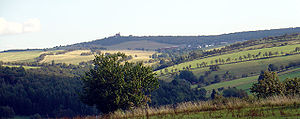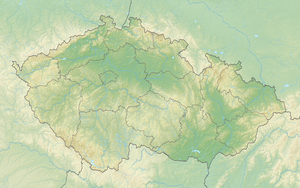Komáří hůrka
| Komáří hůrka | ||
|---|---|---|
|
View of the Mückenberg from the north |
||
| height | 807.5 m nm | |
| location | Ústecký kraj , Czech Republic | |
| Mountains | Ore Mountains | |
| Coordinates | 50 ° 42 '24 " N , 13 ° 51' 24" E | |
|
|
||
| rock | Biotite gneiss with tin mineralization | |
| Development | 1568 by tin mining | |
Komáří hůrka ( German Mückenberg ) is a mountain in the Bohemian Eastern Ore Mountains . Located directly on the Erzgebirge ridge, it is an important landmark in the region. The summit is built over with a mountain hotel, from Bohosudov ( Mariaschein ) a chairlift leads to the summit.
Until recently, mining for tin and other ores was important on the Mückenberg . The bell tower integrated into the mountain hotel , several pings and extensive mountain heaps testify to this.
Location and surroundings
The Mückenberg lies northeast of Krupka ( Graupen ) and southeast of Cínovec ( Bohemian Zinnwald ) directly on the striking steep drop of the Ore Mountains . This makes it a striking vantage point , from which a view in almost all directions is possible. In addition, from the Mückenberg, the typical character of a shed clod for the Erzgebirge with the steep drop to the south becomes clear in a vivid way.
Surname
The German name of the mountain can be traced back to an old legend which tells of a poacher who stole chickens and geese in Fojtovice (Voitsdorf). Because of his speed, he was constantly able to escape from the angry farmers. When he tried to steal an old mother's only cow, she raised her divining rod and shouted: "You should be bitten by mosquitoes before you reach the top of the mountain!" The mountain has been named after him ever since.
history
Mining
At the turn of the 12th to the 13th century, the area around Graupen was one of the most important tin mining areas in Europe. The search for further tin ore deposits brought miners to the Erzgebirgskamm am Mückenberg in the 14th century. Mining on the Mückenberg was first mentioned in a document in 1416. Centuries of extraction have left clearly visible traces in the landscape around the mountain. Numerous old tunnels are hidden beneath its surface, and parts of its mountain slope are covered with pings .
Summit development and construction
In 1568 a stone tower (usually referred to as the "bastion") was built by the Graupener miners under the miner David Koith on the summit. A bell was hung in this to announce the times of day and the start and end of the shift to the miners of the surrounding tin mines. There is also a document dated June 25, 1692, which ordered a prayer for the miners three times a day when the bells were ringing accordingly. The ringing was done by a disused miner, who was referred to as a "ringing". He had his apartment in a small house attached to the tower. The location of the tower was not only the highest point, but also roughly the center of the Graupen tin mining, because the Geisinger mines also belonged to the Graupen mountain lords at the time. The name mosquito tower (Czech: Komáří vížka ) became popular for this tower .
The tower remained unchanged in shape until 1857. The owner at the time, the Graupener Bergverwalter Raimund Zechel, had the attached house demolished and a pub built instead. The tower was included in the construction and in accordance with the contract a free apartment was handed over to the annex. As a result, the mountain became a magnet for tourists, the number of which tended to increase. Previously only visited in summer, winter tourism began in the first third of the 20th century, benefiting from the boom in winter sports.
cable railway
As early as 1914 there were plans for a cable car up the mountain. However, the First World War prevented the execution.
At the beginning of the 1930s there were again plans to build a cable car from the south to the Erzgebirgskamm. Since this project intended to transport large loads (trucks and wagons), it was decided to build the funicular from Mariaschein to the summit of the Klösenberg, southwest of the Mückenberg. The project envisaged a 1794-meter-long, standard-gauge funicular railway that could transport 60 to 100 people or 6 to 10 tons of load over a height difference of 457 meters in 15 minutes at a speed of 2 m / s. In continuation of the road freight traffic (especially coal transports) to Saxony, the existing path from the summit to the road connection Mückenberg-Voitsdorf-Müglitz-Lauenstein should be expanded accordingly. So that the railway could transport coal transports up the mountain without reloading, platform trucks were provided on which vehicles could be transported. In the summer of 1932, surveying work had already been carried out and the construction plans submitted to the responsible ministry. To finance the "Seilbahn Mariaschein-Mückenberg A.-G." should be founded and shares should be issued. It is not known why this well-advanced project ultimately did not come to fruition.
Between 1950 and 1952, a double chairlift from Bohosudov to the summit was actually built according to the Swiss von Roll VR101 system , which at 2348 meters was the longest chairlift in Central Europe at the time of its construction. It overcomes a difference in altitude of 482 meters. Even today, the railway, built under a Swiss license by Transporta Chrudim , is considered the longest in the Czech Republic with no intermediate station. It is the last plant of its type in operation in Europe.
view
The view is particularly rewarding to the south of the Bohemian Central Mountains , to the east to the Elbe Sandstone Mountains and to the west to the main ridge of the Ore Mountains. To the north, the Geisingberg and the Kohlhaukuppe block a comprehensive view of Saxony, but if the visibility is good, the Elbe valley with Dresden can be made out.
Paths to the summit
- Direct access to the summit is possible by car.
- The double chairlift described above goes from Krupka to the summit.
- On foot along several marked hiking trails, for example via the Alte Dresden-Teplitzer Poststrasse and the Kyšperk Castle .
- From the parking lot in Fürstenau (at the customs house) over the hiking crossing, through Fojtovice , it is about 5 kilometers.
- Since the Czech Republic joined the Schengen Agreement, the mosquito tower can also be reached from the village of Müglitz . The footpath, which can be covered in about 90 minutes, runs along the remains of the village of Mohelnice .
- The European long-distance hiking trail E3 leads over the Komáří hůrka.
- At the same time a cross- border mining educational trail running from Krupka via Geising and Altenberg to Zinnwald .
- In winter, the Krušnohorská lyžařská magistrála Krušnohorská Magistrála runs from Cínovec over the mountain to Nakléřov .
literature
- Karl Rudolph: The mosquito tower - a jubilee . In: Nordwestböhmischer Gebirgsvereins-Verband (Hrsg.): Erzgebirgs-Zeitung. Monthly for folklore and local history, hiking care and tourism . 7th and 8th issue of the 39th year, July – August. Teplitz-Schönau 1918, p. 71-72 ( digitized version ).
Web links
Individual evidence
- ↑ Karl Rudolph: The mosquito tower - one honoree. ..., p. 71.
- ↑ Karl Rudolph: The mosquito tower - one honoree. ..., p. 72.
- ↑ Joseph Keith: From the Mückenbergbahn. In: Erzgebirgs-Zeitung. 5th issue of the 54th volume, May 1933, pp. 57–58. ( Digitized version )
- ↑ Joseph Keith: The funicular to Mückenberg. In: Erzgebirgs-Zeitung. 4th issue of the 54th volume, April 1933, pp. 39–42. ( Digitized version )





